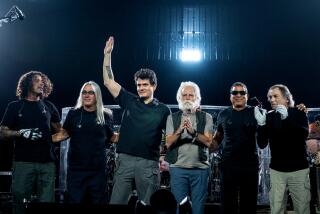Weir, Lesh, Hart Bring Dead to Life
- Share via
What would you call a new band featuring three key members of the Grateful Dead performing three-hour sets of the old band’s music?
Dead Again? Half Dead? Dead Remains?
Deadheads are calling it the answer to their prayers. The name is the one thing left to be determined in plans for a tour this summer by singer-guitarist Bob Weir, bassist Phil Lesh and percussionist Mickey Hart, along with auxiliary Dead keyboardist Bruce Hornsby.
They will anchor a band that will headline the third annual Furthur Festival, a Dead-related tour created in the wake of Jerry Garcia’s August 1995 death to keep the Deadhead community together. Hornsby is expected to handle most of the lead vocals on songs that had been sung by Garcia, while most of Garcia’s lead guitar work will be turned over to jazz-oriented musician Stan Franks, though there is talk of guests joining in on some shows, with such names as Bob Dylan and Eric Clapton popping up in the Deadhead rumor mill.
Dead spokesman Dennis McNally would not confirm the plans, but sources close to the band say that Lesh, who had declined similar proposals, found he was missing the experience of performing the music that had been his life for 30 years.
Short of Garcia’s resurrection, it’s the news many Deadheads have most been hoping to hear.
“They had talked about [reuniting] at the end of the millennium, but why wait?” says Toni Brown, publisher of Brooklyn-based Deadhead magazine Relix. “We were all tired of waiting.”
Others who were waiting for such news are concert promoters, who had missed the reliable and sizable business of a Grateful Dead tour. In the decade before Garcia’s death, the San Francisco band pitched camp annually among the top-grossing tours with steady sales at both arenas and stadiums.
The Furthur Festival, even with Weir and Hart each fronting bands, couldn’t come close to that. Last year, with the Black Crowes headlining, the tour was only the 47th-biggest U.S. tour, averaging attendance of about 8,600 and a total box-office gross of $6.3 million for 28 dates, according to figures compiled by Pollstar magazine.
“It won’t fill the [Dead’s] hole,” Gary Bongiovanni, Pollstar’s editor-in-chief, says of the reunion. “But that’s not to say it won’t be a great touring act. And obviously with the higher profile connected to the Dead name, you’d expect it to do much better this year.”
Can the music live up to the Dead?
“Without Jerry it’s a totally different thing,” Brown says. “But last year many people said the most rewarding thing was when Weir finally played Dead tunes. And having new players gives it credibility and its own voice. And who knows? It could blossom into something of its own.
DEAD TIME: While they’re waiting for summer, Deadheads can keep busy reliving the old days with “The Deadhead’s Taping Compendium, Volume I,” an in-depth guide to the vast flow of concert tapes traded freely among the most serious fans.
Compiled by Michael M. Getz and John R. Dwork, the book is due in May. So detailed are its show-by-show descriptions and analyses of available tapes that its nearly 600 pages take us only through 1974.
However, it does reach back way before the Dead itself came together, starting with a 1959 show by the College of San Mateo Jazz Band, which included Phil Lesh on trumpet. There are also such oddities as a 1962 recording of Jerry Garcia’s folk band the Sleepy Hog Hollow Stompers at the San Carlos Jewish Community Center. It’s much more information than anyone who isn’t obsessed with finding the greatest-ever performance of “Dark Star” needs, but even a casual Deadhead should get some flashbacks thumbing through these pages.
More to Read
The biggest entertainment stories
Get our big stories about Hollywood, film, television, music, arts, culture and more right in your inbox as soon as they publish.
You may occasionally receive promotional content from the Los Angeles Times.










